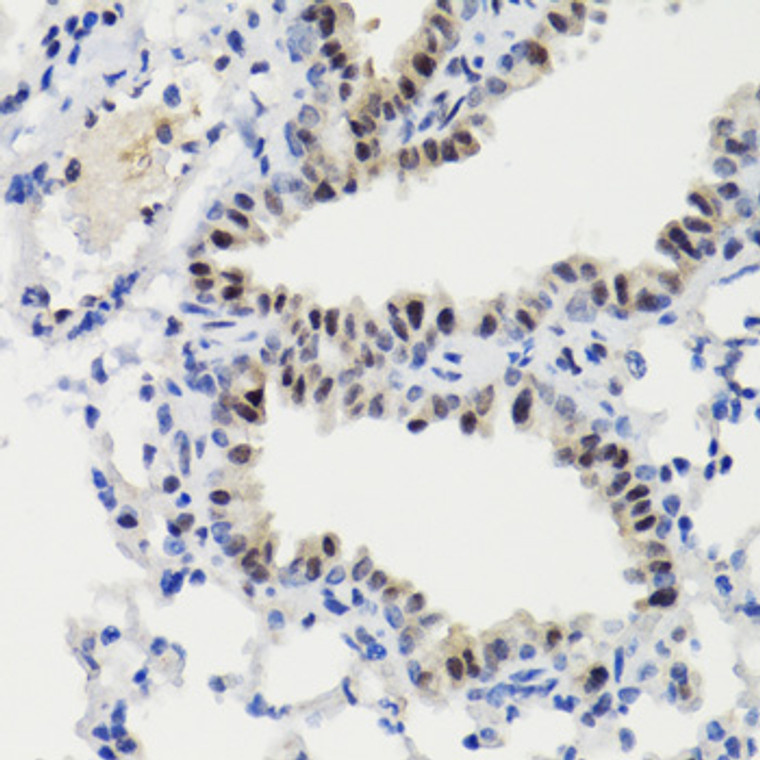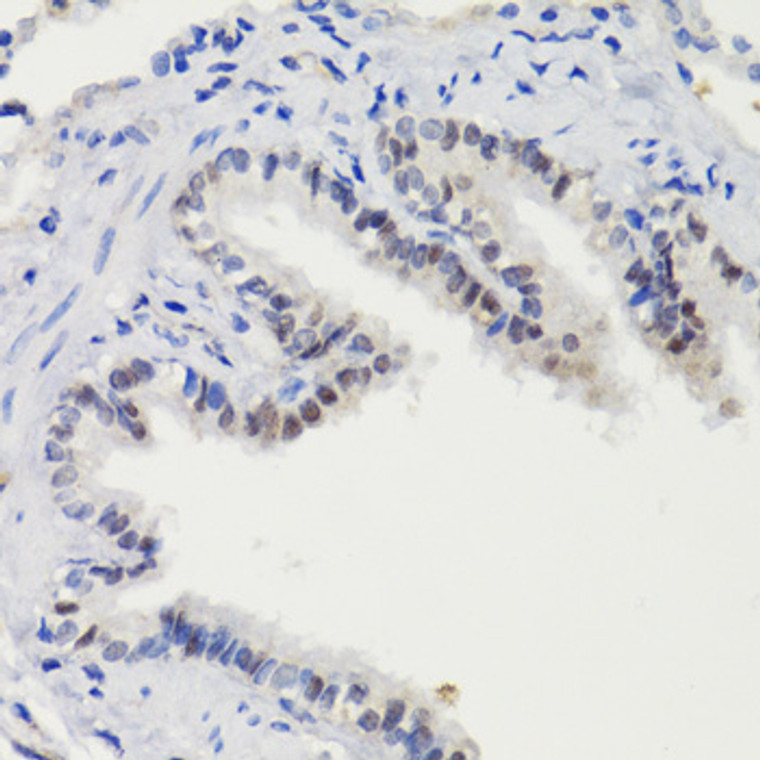| Host: |
Rabbit |
| Applications: |
WB/IHC/IP |
| Reactivity: |
Human/Mouse/Rat |
| Note: |
STRICTLY FOR FURTHER SCIENTIFIC RESEARCH USE ONLY (RUO). MUST NOT TO BE USED IN DIAGNOSTIC OR THERAPEUTIC APPLICATIONS. |
| Short Description: |
Rabbit polyclonal antibody anti-Phospho-Stat3-S727 is suitable for use in Western Blot, Immunohistochemistry and Immunoprecipitation research applications. |
| Clonality: |
Polyclonal |
| Conjugation: |
Unconjugated |
| Isotype: |
IgG |
| Formulation: |
PBS with 0.01% Thimerosal, 50% Glycerol, pH7.3. |
| Purification: |
Affinity purification |
| Dilution Range: |
WB 1:500-1:1000IHC-P 1:50-1:200IP 1:50-1:100 |
| Storage Instruction: |
Store at-20°C for up to 1 year from the date of receipt, and avoid repeat freeze-thaw cycles. |
| Gene Symbol: |
STAT3 |
| Gene ID: |
6774 |
| Uniprot ID: |
STAT3_HUMAN |
| Immunogen: |
A synthetic phosphorylated peptide around S727 of human Phospho-STAT3-S727 (NP_644805.1). |
| Immunogen Sequence: |
PMSPR |
| Tissue Specificity | Heart, brain, placenta, lung, liver, skeletal muscle, kidney and pancreas. Expressed in naive CD4(+) T cells as well as T-helper Th17, Th1 and Th2 cells. |
| Post Translational Modifications | Tyrosine phosphorylated upon stimulation with EGF. Tyrosine phosphorylated in response to constitutively activated FGFR1, FGFR2, FGFR3 and FGFR4. Activated through tyrosine phosphorylation by BMX. Tyrosine phosphorylated in response to IL6, IL11, LIF, CNTF, KITLG/SCF, CSF1, EGF, PDGF, IFN-alpha, LEP and OSM. Activated KIT promotes phosphorylation on tyrosine residues and subsequent translocation to the nucleus. Phosphorylated on serine upon DNA damage, probably by ATM or ATR. Serine phosphorylation is important for the formation of stable DNA-binding STAT3 homodimers and maximal transcriptional activity. ARL2BP may participate in keeping the phosphorylated state of STAT3 within the nucleus. Upon LPS challenge, phosphorylated within the nucleus by IRAK1. Upon erythropoietin treatment, phosphorylated on Ser-727 by RPS6KA5. Phosphorylation at Tyr-705 by PTK6, isoform M2 of PKM (PKM2) or FER leads to an increase of its transcriptional activity. Dephosphorylation on tyrosine residues by PTPN2 negatively regulates IL6/interleukin-6 signaling. Acetylated on lysine residues by CREBBP. Deacetylation by LOXL3 leads to disrupt STAT3 dimerization and inhibit STAT3 transcription activity. Oxidation of lysine residues to allysine on STAT3 preferentially takes place on lysine residues that are acetylated. Some lysine residues are oxidized to allysine by LOXL3, leading to disrupt STAT3 dimerization and inhibit STAT3 transcription activity. Oxidation of lysine residues to allysine on STAT3 preferentially takes place on lysine residues that are acetylated. (Microbial infection) Phosphorylated on Tyr-705 in the presence of S.typhimurium SarA. |
| Function | Signal transducer and transcription activator that mediates cellular responses to interleukins, KITLG/SCF, LEP and other growth factors. Once activated, recruits coactivators, such as NCOA1 or MED1, to the promoter region of the target gene. May mediate cellular responses to activated FGFR1, FGFR2, FGFR3 and FGFR4. Upon activation of IL6ST/gp130 signaling by interleukin-6 (IL6), binds to the IL6-responsive elements identified in the promoters of various acute-phase protein genes. Activated by IL31 through IL31RA. Acts as a regulator of inflammatory response by regulating differentiation of naive CD4(+) T-cells into T-helper Th17 or regulatory T-cells (Treg): deacetylation and oxidation of lysine residues by LOXL3, leads to disrupt STAT3 dimerization and inhibit its transcription activity. Involved in cell cycle regulation by inducing the expression of key genes for the progression from G1 to S phase, such as CCND1. Mediates the effects of LEP on melanocortin production, body energy homeostasis and lactation. May play an apoptotic role by transctivating BIRC5 expression under LEP activation. Cytoplasmic STAT3 represses macroautophagy by inhibiting EIF2AK2/PKR activity. Plays a crucial role in basal beta cell functions, such as regulation of insulin secretion. |
| Protein Name | Signal Transducer And Activator Of Transcription 3Acute-Phase Response Factor |
| Database Links | Reactome: R-HSA-1059683Reactome: R-HSA-111453Reactome: R-HSA-1266695Reactome: R-HSA-1433557Reactome: R-HSA-1839117Reactome: R-HSA-186763Reactome: R-HSA-198745Reactome: R-HSA-201556Reactome: R-HSA-2559582Reactome: R-HSA-2586552Reactome: R-HSA-2892247Reactome: R-HSA-390471Reactome: R-HSA-452723Reactome: R-HSA-6783783Reactome: R-HSA-6785807Reactome: R-HSA-8849474Reactome: R-HSA-8854691Reactome: R-HSA-8875791Reactome: R-HSA-8983432Reactome: R-HSA-8984722Reactome: R-HSA-8985947Reactome: R-HSA-9008059Reactome: R-HSA-9020933Reactome: R-HSA-9020956Reactome: R-HSA-9020958Reactome: R-HSA-9616222Reactome: R-HSA-9670439Reactome: R-HSA-9673767Reactome: R-HSA-9673770Reactome: R-HSA-9674555Reactome: R-HSA-9680350Reactome: R-HSA-9701898Reactome: R-HSA-9705462Reactome: R-HSA-9707564Reactome: R-HSA-9725370Reactome: R-HSA-9725371Reactome: R-HSA-982772 |
| Cellular Localisation | CytoplasmNucleusShuttles Between The Nucleus And The CytoplasmTranslocated Into The Nucleus Upon Tyrosine Phosphorylation And DimerizationIn Response To Signaling By Activated Fgfr1Fgfr2Fgfr3 Or Fgfr4Constitutive Nuclear Presence Is Independent Of Tyrosine PhosphorylationPredominantly Present In The Cytoplasm Without StimuliUpon Leukemia Inhibitory Factor (Lif) StimulationAccumulates In The NucleusThe Complex Composed Of Bart And Arl2 Plays An Important Role In The Nuclear Translocation And Retention Of Stat3Identified In A Complex With Lyn And Pag1 |
| Alternative Antibody Names | Anti-Signal Transducer And Activator Of Transcription 3 antibodyAnti-Acute-Phase Response Factor antibodyAnti-STAT3 antibodyAnti-APRF antibody |
Information sourced from Uniprot.org
12 months for antibodies. 6 months for ELISA Kits. Please see website T&Cs for further guidance


















